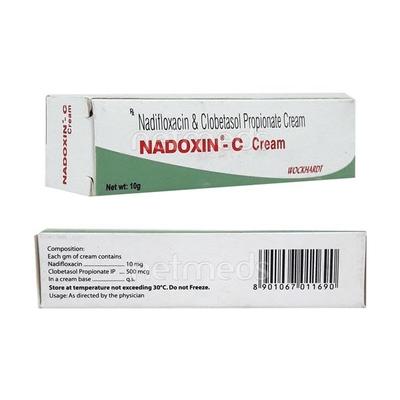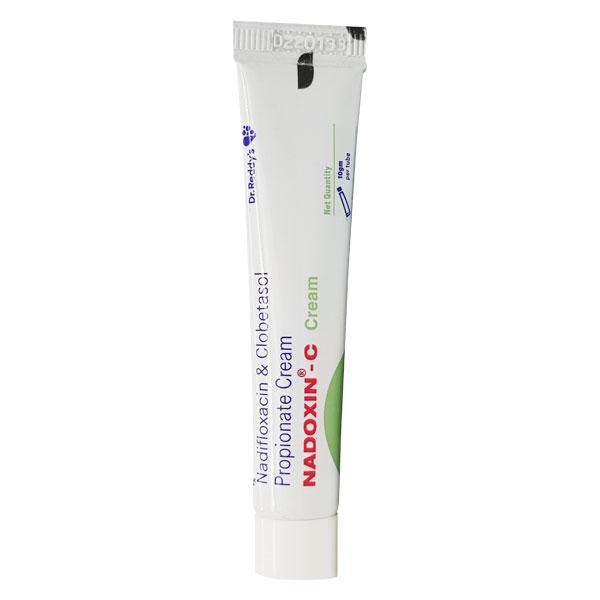

Netmeds First Membership
Quick Links
Introduction About NADOXIN C CREAM
NADOXIN C CREAM is a combination of Clobetasol propionate and Nadifloxacin which belong to a group of medicines called Topical Corticosteroids and Fluoroquinolones, respectively. NADOXIN C CREAM is used to manage contact dermatitis, erythema multiforme and infective eczema.
Contact dermatitis is a condition characterised by an itchy rash that occurs due to direct contact with a substance or an allergic reaction to it. Erythema multiforme is a skin disorder that occurs due to an allergic reaction to a medicine or an infection and is generally characterised by symptoms such as sudden, red patches and blisters on the face, hands and soles of feet, itching and cold sores.
Infective eczema is a chronic skin condition that cracks, dries, inflames and irritates the skin, leading to a bacterial or viral infection that is generally characterised by symptoms such as fever, weakness and swollen lymph nodes.
NADOXIN C CREAM is not recommended for use in patients with skin problems such as acne (pimples) or rosacea (severe flushing of the skin on and around your nose) or perioral dermatitis (spotty red rash around your mouth), itchy skin, skin infection, itching around the anus or vagina and widespread plaque psoriasis (itchy skin disease).
Before applying NADOXIN C CREAM, inform your doctor if you smoke, have broken or damaged skin, have a large site of application, have psoriasis (itchy skin), have a chronic leg ulcer or have thin skin (as a site of application). NADOXIN C CREAM should be used with caution during pregnancy and is not recommended for use when applied to the breasts while feeding a baby.
NADOXIN C CREAM is also not recommended for use in children (below 1 year) and should be used with caution in children (over 1 year) and adolescents (below 18 years). The most common symptoms of applying NADOXIN C CREAM are burning, pain, irritation or itching sensation at the site of application. Consult your doctor if any of these symptoms get worse.
Uses Of NADOXIN C CREAM
- Manage contact dermatitis
- Manage erythema multiforme
- Manage infective eczema
How NADOXIN C CREAM Works
NADOXIN C CREAM helps to manage allergic and bacterial skin infections, where Clobetasol manages inflammation by blocking the production of certain chemical messengers (prostaglandins) that make the skin red, swollen & itchy and Nadifloxacin manages bacterial growth by inhibiting their protein synthesis that results in bacteriostatic effect.
How to use NADOXIN C CREAM
Always apply NADOXIN C CREAM, as directed by your physician. It is for external use only. On the affected area, apply a thin layer of this medicine. Managed areas on the face need not be covered with a plaster or bandage. Do not apply NADOXIN C CREAM on your face beyond 5 days. Avoid applying NADOXIN C CREAM around your eyes, including eyelids.
Side Effects Of NADOXIN C CREAM
Common
- feeling burning, pain, irritation or itching sensation at the site of application
Uncommon
- stretch marks due to skin thinning
- noticeable blood vessels under the surface of the skin
Rare
Stop applying NADOXIN C CREAM and contact your doctor if you experience any of the following side effects:
- signs of an allergic reaction such as generalized rash or swollen skin at the site of application
- signs of pustular psoriasis (rare skin disorder marked by yellowish pustules on the skin) such as raised bumps with pus under the skin
How To Manage Side Effects
Itchy Skin:
Avoid scratching your skin. Cool your skin by holding on to a damp towel. Try to have cool or warm baths. Wear loose clothing and do not wear tight clothes. Try to avoid using perfumed soaps, deodorants or moisturizers and always use unscented moisturizers.
Warning & Precautions
Pregnancy
NADOXIN C CREAM should be used with caution during pregnancy and in women planning for pregnancy. Consult your doctor before applying the medicine.
Breastfeeding
NADOXIN C CREAM is not recommended for use when applied to the breasts while feeding the baby. Consult your doctor before applying for the medicine.
Allergy
NADOXIN C CREAM is not recommended for use if you are allergic to clobetasol propionate, nadifloxacin or any other ingredients of this medicine.
Others
NADOXIN C CREAM is not recommended for use if you:
- have skin problems such as acne (pimples), rosacea (severe flushing of skin on and around your nose), perioral dermatitis (spotty red rash around your mouth)
- have itching around your anus or vagina
- have a skin infection
- have itchy skin
- have widespread plaque psoriasis (itchy skin disease), except single lesions
Before applying NADOXIN C CREAM, inform your doctor if you:
- have previously had an allergic reaction to another steroid
- are planning to apply the cream under an airtight dressing, including a child’s nappy
- are applying the cream on broken/damaged skin or within skin folds
- the site of the application is large
- have psoriasis (itchy skin)
- have a chronic leg ulcer
- are applying to thin skin such as the face
- smoke
Use in Pediatrics:
NADOXIN C CREAM is not recommended for use in children (below 1 year). It should be used with caution in infants, children (above 1 year) and adolescents (below 18 years). The medicine should not be used with dressings or bandages while managing children. Consult your doctor before applying NADOXIN C CREAM.
Use in Geriatrics:
NADOXIN C CREAM should be used with caution in elderly patients (aged 65 years or above). Consult your doctor before applying NADOXIN C CREAM.
Interactions
A. Drug-Drug Interactions:
Before applying NADOXIN C CREAM, inform your doctor if you are applying any of the following medicine:
- Other steroids (medicine used for allergies, asthma, eczema, inflammatory bowel disease, Addison's disease and arthritis) Ex. prednisolone, betamethasone, dexamethasone
Overdosage:
If you or anyone else applied too much of NADOXIN C CREAM or accidentally swallowed the medicine, consult your doctor immediately or visit the nearby hospital.
Synopsis
| Drug | : | Clobetasol propionate, Nadifloxacin |
| Pharmacological Category | : | Topical Corticosteriods, Fluoroquinolones |
| Therapeutic Indication | : | Contact dermatitis, erythema multiforme and infective eczema |
| Dosage Forms | : | Cream, Gel |
More Information
- Keep NADOXIN C CREAM out of reach from children
- Store NADOXIN C CREAM at room temperature
FAQs About NADOXIN C CREAM
Q: What is the function of NADOXIN C CREAM?
A: NADOXIN C CREAM is a combination of Clobetasol propionate and Nadifloxacin that belongs to a group of medicines called topical corticosteroids and fluoroquinolones and is used to manage contact dermatitis, erythema multiforme and infective eczema in affected individuals.
Q: What happens if you forget to apply NADOXIN C CREAM?
A: If you forget to apply NADOXIN C CREAM, then try to apply it as soon as you remember. If the time is right for the next application, then carry on as normal. Try to remember to apply NADOXIN C CREAM as per its application time to avoid the risks of returning infection.
Q: Is NADOXIN C CREAM safe to be used by children?
A: NADOXIN C CREAM is not recommended for use in children under the age of one year. It should be used with caution in infants, children (above 1 year) and adolescents (below 18 years). The medicine should not be used with dressings or bandages while managing children. Consult your doctor before applying NADOXIN C CREAM.
Q: Who should avoid applying NADOXIN C CREAM?
A: NADOXIN C CREAM should not be used in patients who are allergic to clobetasol propionate or nadifloxacin or in patients who have skin problems such as acne (pimples), rosacea (severe flushing of the skin on and around your nose), perioral dermatitis (spotty red rash around your mouth), itching around the anus or vagina, skin infection, itchy skin and widespread plaque.
Q: Is NADOXIN C CREAM safe to be used by pregnant and breastfeeding women?
A: NADOXIN C CREAM should be used with caution in pregnant women and is not recommended for use when applied to the breasts while feeding the baby. Consult your doctor before applying the medicine.
References
1. KD Tripathi. Drugs Acting on Skin and Mucous Membranes. Essentials of medical pharmacology. Seventh edition. 2013. Page – 894, 895.
2. Clobetasol propionate. NIH National Library of Medicine. National Center for Biotechnology Information. PubChem [Revised in July 2022] [Accessed on 8th July 2022] https://pubchem.ncbi.nlm.nih.gov/compound/Clobetasol-propionate#section=Biological-Half-Life
3. Aura Rusu, Ioana-Andreea Lungu, Octavia-Laura Moldovan, Corneliu Tanase and Gabriel Hancu. Structural Characterization of the Millennial Antibacterial (Fluoro) Quinolones—Shaping the Fifth Generation. NIH National Library of Medicine. National Center for Biotechnology Information. PMC PubMed Central. [Revised in August 2021] [Accessed on 8th July 2022] https://www.ncbi.nlm.nih.gov/pmc/articles/PMC8399897/
4. Varsha Narayanan, Salman Motlekar, Ganesh Kadhe and Seema Bhagat. Efficacy and Safety of Nadifloxacin for Bacterial Skin Infections: Results from Clinical and Post-Marketing Studies. NIH National Library of Medicine. National Center for Biotechnology Information. PMC PubMed Central. [Revised in December 2014] [Accessed on 8th July 2022] https://www.ncbi.nlm.nih.gov/pmc/articles/PMC4257952/
5. Tiofarma B.V. Electronic medicines compendium (EMC). [Revised in February 2022] [Accessed on 8th July 2022] https://www.medicines.org.uk/emc/files/pil.10359.pdf
6. CiplaMed. NADIBACT Cream/Gel (Nadifloxacin 1%). [Accessed on 8th July 2022] https://www.ciplamed.com/content/nadibact-creamgel
7. CANBRO Healthcare. NADIX-C. [Accessed on 8th July 2022] https://www.canbro.in/product/nadifloxacin-10mg-clobetasol-propionate-500-mcg-cream
Useful Diagnostic Tests
- Patch test








